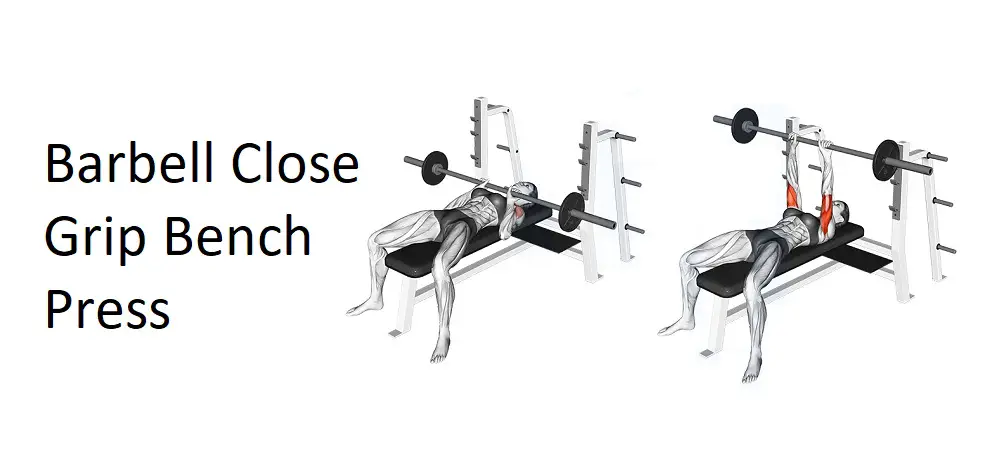Table of Contents
Introduction
The Barbell Close Grip Bench Press is a compound exercise that emphasizes the triceps, chest, and shoulders. A variation of the standard bench press, it involves a closer hand placement on the barbell, which shifts more of the workload onto the triceps. This makes it an excellent choice for building arm strength and improving lockout performance in pressing movements.
Favored by bodybuilders, powerlifters, and athletes, the close grip bench press is a versatile exercise that enhances both aesthetics and functional strength. Whether your goal is to sculpt defined arms, improve your bench press, or boost your overall upper body strength, the barbell close grip bench press deserves a place in your routine.
Benefits of the Barbell Close Grip Bench Press
1. Increased Triceps Strength and Size
- The narrow grip emphasizes the triceps, particularly the long head, making it one of the best exercises for developing triceps strength and hypertrophy.
2. Improved Bench Press Performance
- As the triceps play a critical role in the lockout phase of the bench press, training with a close grip can enhance your performance in the standard bench press.
3. Balanced Upper Body Development
- While the chest and shoulders are secondary movers, they are still actively engaged, promoting balanced muscle growth in the upper body.
4. Functional Strength Gains
- The barbell close grip bench press mimics real-life pushing movements, improving performance in sports and daily activities.
5. Reduced Shoulder Strain
- The narrower grip places less stress on the shoulder joint compared to a traditional bench press, making it a safer option for those with shoulder concerns.
How to Perform the Barbell Close Grip Bench Press
Proper Setup
- Choose the Right Weight:
- Begin with a manageable load to master the form before increasing the resistance.
- Bench and Bar Positioning:
- Lie on a flat bench with your feet firmly planted on the floor.
- Position your eyes directly under the barbell, ensuring it’s securely racked.
Step-by-Step Execution
- Grip the Barbell:
- Use a grip slightly narrower than shoulder-width (6–12 inches apart). Avoid gripping too narrowly, as it can strain the wrists.
- Lift Off:
- Unrack the barbell and hold it directly above your chest with straight arms.
- Lower the Barbell:
- Slowly lower the barbell to your chest, keeping your elbows tucked close to your torso.
- Stop when the bar lightly touches your chest (approximately at the lower sternum).
- Press Back Up:
- Drive the barbell upward in a straight line until your arms are fully extended.
- Avoid locking out the elbows completely to maintain tension in the muscles.
- Repeat:
- Perform 3–4 sets of 8–12 repetitions, focusing on controlled movements throughout.
Form Tips
- Maintain Wrist Neutrality: Keep your wrists straight to prevent strain.
- Elbow Positioning: Tuck your elbows at a 45-degree angle to your torso.
- Core Engagement: Tighten your core to stabilize your body during the lift.
- Controlled Tempo: Avoid bouncing the bar off your chest or using momentum.
Common Mistakes to Avoid
1. Using an Excessively Narrow Grip
- A grip too close can strain the wrists and decrease lifting efficiency.
2. Flared Elbows
- Flaring the elbows outward reduces triceps engagement and increases shoulder strain.
3. Arching the Lower Back Excessively
- Maintain a slight arch for stability but avoid over-arching, which can lead to injury.
4. Rushing the Movement
- Perform each rep with control to maximize muscle activation and prevent injury.
5. Neglecting Warm-Up
- Always warm up with lighter weights or mobility exercises to prepare your muscles and joints.
Muscles Worked
Primary Muscles
- Triceps Brachii: The close grip isolates the triceps, particularly the long head, for strength and size.
Secondary Muscles
- Pectoralis Major (Chest): While the chest takes a secondary role, it still contributes to the pressing motion.
- Deltoids (Shoulders): The anterior deltoids assist in stabilizing the barbell.
Stabilizing Muscles
- Core Muscles: Engage to maintain balance and control.
- Forearms: Actively work to stabilize the bar throughout the lift.
Variations of the Barbell Close Grip Bench Press
1. Incline Close Grip Bench Press
- Targets the upper chest and triceps more intensely.
2. Decline Close Grip Bench Press
- Places greater emphasis on the lower chest and triceps.
3. Smith Machine Close Grip Bench Press
- Provides additional stability, making it suitable for beginners or those recovering from injury.
4. Close Grip Dumbbell Press
- A dumbbell variation that allows for a greater range of motion and improved muscle engagement.
5. Paused Close Grip Bench Press
- Involves pausing at the bottom of the lift to enhance strength and control.
Incorporating the Barbell Close Grip Bench Press into Your Routine
Frequency
- Perform the close grip bench press 1–2 times per week as part of your upper body or arm-focused workout.
Suggested Pairing
- Pair with overhead triceps extensions, skull crushers, and tricep dips for a comprehensive arm workout.
- Include in a chest day routine alongside incline presses and flyes for balanced development.
Programming for Strength and Hypertrophy
For Strength
- 4–6 sets of 4–6 reps with heavier weights (75–90% of your one-rep max).
For Hypertrophy
- 3–4 sets of 8–12 reps with moderate weights (60–75% of your one-rep max).
Safety Considerations
- Spotter Assistance: Always have a spotter when lifting heavy weights.
- Gradual Progression: Increase weight gradually to avoid overloading.
- Wrist Protection: Consider using wrist wraps for added support.
Video Demonstration
Watching a video tutorial is an excellent way to refine your technique for Barbell Close Grip Bench Press.
FAQs
1. Is the close grip bench press suitable for beginners?
Yes, but beginners should start with light weights to master the form and avoid injury.
2. Can I perform this exercise with dumbbells?
Yes, the dumbbell close grip press is an effective alternative that allows for greater range of motion.
3. How close should my grip be?
A grip width of 6–12 inches apart is ideal for targeting the triceps while minimizing wrist strain.
4. Is this exercise better than tricep dips?
Both exercises are effective for triceps development, but the close grip bench press allows for heavier loading.
5. Can it replace the standard bench press?
While it’s an excellent triceps-focused variation, it shouldn’t replace the standard bench press in a balanced workout routine.
Conclusion
The Barbell Close Grip Bench Press is a powerhouse exercise for building strong, defined triceps while also enhancing upper body strength and stability. Its versatility, safety, and effectiveness make it a valuable addition to any workout routine. Whether you’re a beginner or an advanced lifter, mastering this exercise will significantly improve your pushing power and arm aesthetics.
Incorporate the close grip bench press into your routine, pair it with complementary exercises, and watch your upper body strength and size soar.
Other Exercises
Also, read The Close-Grip Bench Press








